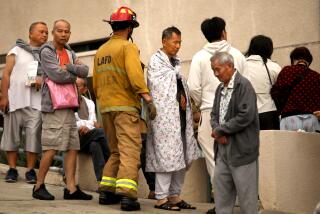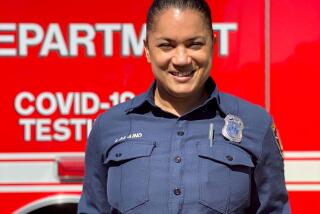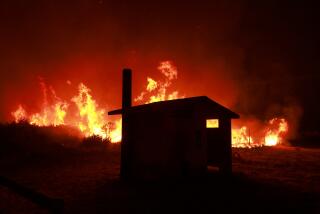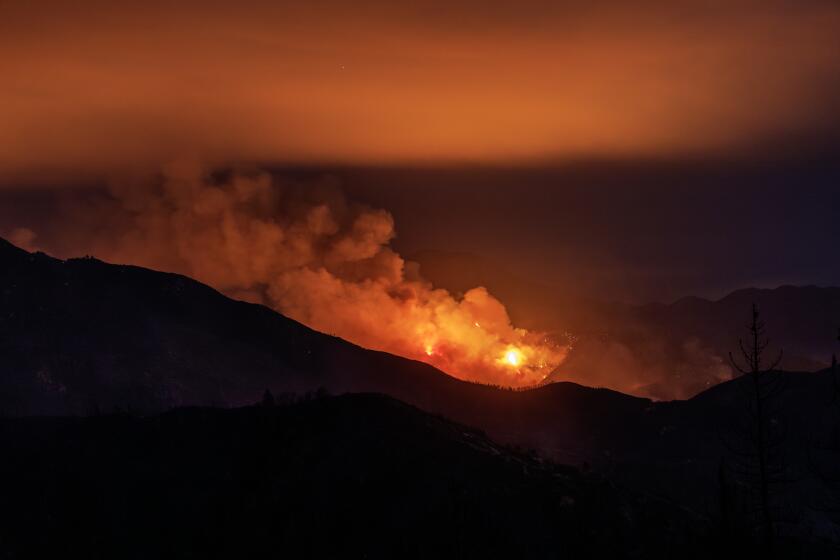Column: Why did no one warn the housekeepers about the Getty fire?

Joan Didion once wrote, “The city burning is Los Angeles’s deepest image of itself.”
Wildfire season never passes without this quote going viral on social media, and while I roll my eyes every time, I understand the impulse. Her words capture the constant unrest that comes with living under threat of disaster and the way imminent destruction shows us who we are. It lets us put a sexy, intellectual spin on the real dangers we face in California.
For the record:
12:01 p.m. Nov. 12, 2019This article reports that Napa Valley winemakers forced their employees to pick grapes two years ago as the Thomas fire burned on the horizon. The fires that swept the region then were the Nuns and Atlas fires.
But lately I’ve started to question how deep that image is. I think it could use some edits to make it relevant in 2019.
First, zoom out from the flames. Show the neighborhood where wealthy homeowners, having fled themselves, have inexplicably forgotten to warn their domestic workers not to come in. Pan over the hill that those workers, largely Latina women, must climb from the bus stop.
Give us a closeup of these women’s faces, so that we might understand why, when everyone else is fleeing for their lives, they walk up the hill toward the flames, fearing that they’ll lose their jobs if they don’t show up, fretting over the day’s pay, the night’s dinner, the month’s rent. Show us the homeowners safe in their hotel rooms and the safety net with the enormous holes in it that immigrants and people of color always seem to fall through.
Now that would be a deep and true image of Los Angeles. And thanks to my colleague Brittny Mejia, we saw that city last Monday. Hours after the Getty fire ignited, she found housekeepers reporting to work, even though the neighborhood was under mandatory evacuation. She saw gardeners trimming hedges with massive plumes of smoke rising in the backdrop. One housekeeper asked Brittny how to text “are you home” in English. Most she spoke to had no idea the neighborhood had been evacuated and had not heard from their employers.
Like many of us, I was heartbroken and angry when I read Brittny’s story. This moment, I felt, was a wakeup call. The sight of some of the most vulnerable people in our city falling through the cracks should represent a moral and humanitarian crisis, a challenge to our shared sense of humanity.
But, I suppose, if our humanity could be challenged like that, it would have been challenged already, two years ago, when my colleague Cindy Carcamo exposed winemakers forcing their employees to pick grapes as the Thomas fire glowed on the horizon.
Didion is right. Fires show us a deep image of ourselves. But is this who we are?
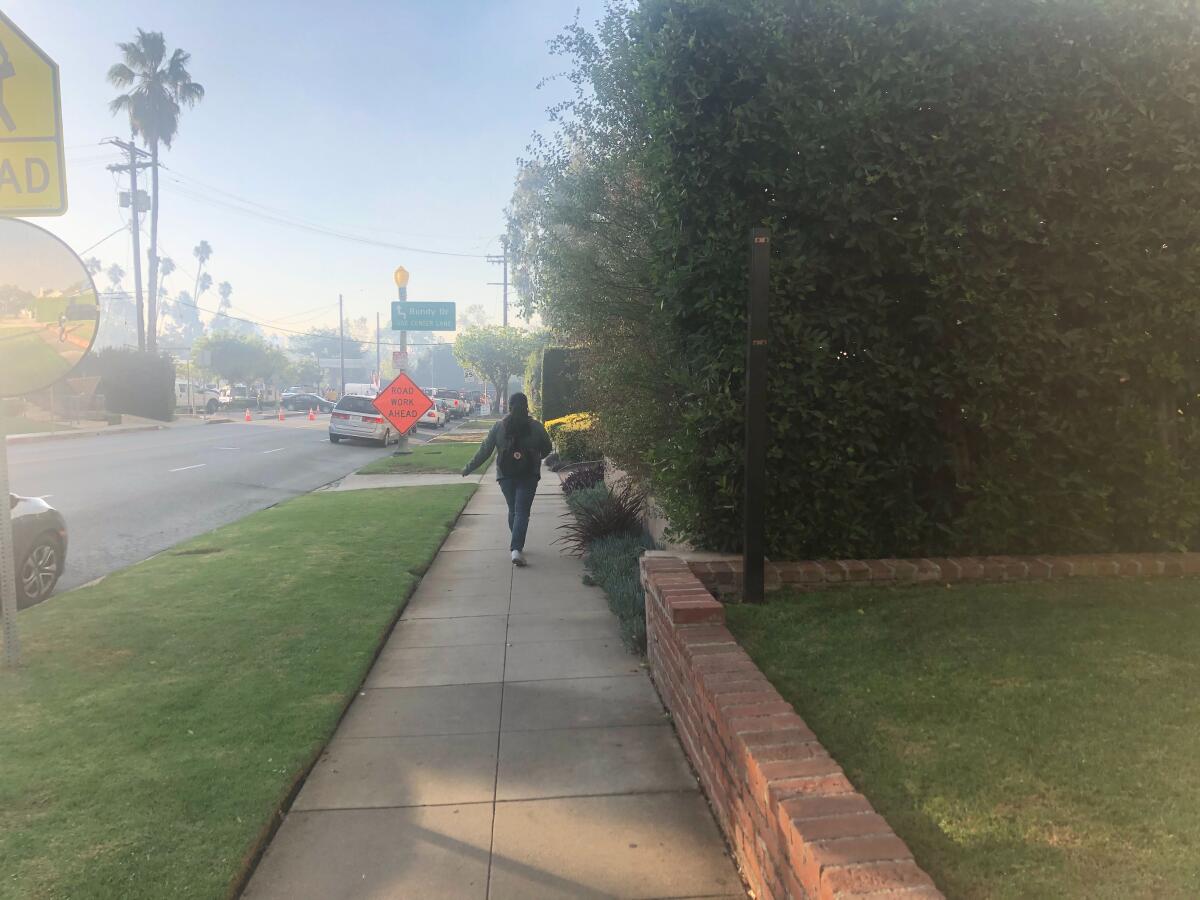
I spent the week trying to understand why no one warned the men and women Brittny met that day. But there really wasn’t a simple answer.
First, I asked the Los Angeles Police Department why multiple domestic workers and gardeners were allowed into a mandatory evacuation zone. What’s the official department policy on who is allowed in? Did the officer stationed at the roadblock warn the gardeners and domestic workers of the danger?
“We would have to look at each circumstance to understand if there was indeed a mandatory evacuation or if it was in the warning area,” was an LAPD spokesman’s answer.
Yeah, I don’t know what that means either. I asked for clarification, but by deadline, the LAPD had not responded.
Then I asked the city and county’s emergency management departments about whether they sent alerts in Spanish or any other language. Was there any way the domestic workers could have been warned in advance? Possibly. The city initially sent out alerts in English, but Spanish-language alerts were available by 5:30 a.m., said Kathleen Hutton, an emergency manager for the city.
Univision and other Spanish-language media also broadcast the evacuation zones and maps early in the morning on TV and on social media. The city also sent warnings about the Getty fire through another system that uses cell towers to send alerts to all smartphones in an affected area, Hutton says. They use a demographic map database that allows them to quickly identify which languages might be needed in a certain area. But the alert system accommodates only the Roman characters used in English, and not everyone has a smartphone.
Hutton says she’s trying to learn lessons from what happened last Monday. They’re working on adding Spanish-language capability to their emergency alert systems.
“In every emergency, there are many people who don’t get alerted. In this case, there was a real gap in terms of communications between employer and employee,” Hutton said.
These cultural and linguistic gaps in emergency response exist all over California.
For example, during the first week of the Thomas fire, emergency information was available only in English, said Genevieve Flores-Haro, associate director for Mixteco Indigena Community Organizing Project in Oxnard.
Emergency response needs to be more culturally aware, said Maegan Ortiz, executive director of Instituto de Educación Popular del Sur de California, an organization that provides various kinds of aid to immigrants.
Groups like Ortiz’s often find themselves functioning as de facto disaster relief during wildfire season because no one else helps the workers they serve. They raise money to help replace lost wages, help people find new jobs and hand out gas masks to those forced to work during air-quality hazards.
“There’s no safety net. There’s no rescue plan that really includes low-wage immigrant workers,” Ortiz said.
Forgetting to notify domestic workers of evacuations is only part of the problem. Immigrants and non-English speakers are often left out of recovery and aid efforts. Immigrant laborers are often hired to deep-clean disaster-hit homes and properties without the proper equipment to protect them from toxic fumes.
And labor advocates say it’s not uncommon to hear stories of domestic workers and immigrant laborers who are ordered to continue working during fire and smoke hazards.
One domestic worker in Santa Rosa who asked that she not be identified for fear of losing her job said that she was actually instructed to remain and safeguard a home in an evacuation zone as her employer fled. She was trapped by the roadblocks and mudslides for about a week. To survive, she shared food and water with a group of day laborers at a home next door who were similarly stranded. When the evacuation orders were lifted, she told her employer that she was leaving, and he asked her to grab a few items from the house.

Resources for domestic and immigrant workers in disaster
That practice should violate labor laws, but when I asked the state Department of Industrial Relations about it, I got a surprising answer.
There’s no labor code preventing a domestic employer from ordering a domestic worker to remain in a mandatory evacuation zone, said Frank Polizzi of the California Division of Occupational Safety and Health. In general, state and federal workplace safety codes requiring employers to provide safe workplaces do not apply to domestic workers. Additionally, if a domestic worker refuses to work in hazardous conditions, there’s no legal protection from retaliation, including firing.
Domestic workers are often immigrants here illegally who cannot afford to lose even a single day’s pay. They are especially vulnerable to exploitation in times of disaster. But few legal protections, of any kind, exist.
In 2013, former Gov. Jerry Brown signed a law that gave domestic workers the right to overtime pay, but other proposed job protections were stripped away by the legislative process.
A new law adopted last year requires the state Office of Emergency Services to create a library of translated emergency notifications that local authorities can use. The bill also gives the office the power to require an agency to translate their emergency notifications as a condition of receiving emergency response-related grant funding.
And in July, state labor authorities adopted an emergency rule that requires employers to monitor air quality, take reasonable steps to reduce exposure and provide masks to employees when the air quality does not meet a minimum standard.
But domestic employers are still exempted from state and federal laws’ definitions of employers.
Domestic worker advocacy organizations such as Hand in Hand are focusing their efforts on trying to improve the relationship between domestic workers and their employers.
They try to engage with homeowners and show empathy because, ultimately, no one can play a bigger role in domestic worker safety in times of disaster than domestic employers themselves.
“We try to meet people where they’re at. We know that while domestic employers can be the most exploitative, they can also be the most generous and loving employers around,” said Lindsay Imai Hong, the group’s California director.
It should be said that many homeowners in the Pacific Palisades did remember to look out for their domestic workers’ safety. I spoke to one of those homeowners, who asked that her name not be used out of privacy concerns.
She emphasized that many homeowners in the area take their roles as domestic employers seriously. Though some domestic workers must walk uphill to their jobs, many homeowners wait at the bottom and pick them up at the bus stop. Though domestic workers may fear for their jobs after missing a day’s work, many homeowners help their domestic workers find new jobs, and even help their workers’ relatives find work.
“They rely on us, and we rely on them, and we don’t take that lightly,” she said.
Talking with the homeowner and Imai Hong reminded me of an important truth. When wildfires, or earthquakes, or mudslides or drought loom, our best protection is and always will be our concern for each other. A community’s strength and resilience ultimately comes from a shared sense of humanity. And any reporter who has covered wildfires can tell you about the powerful, inspiring sense of community that grows in the aftermath of disasters.
The generosity and fellowship you see after fires can make huge cities such as Los Angeles feel like small towns. Last week, I visited four evacuation shelters, and at each of them I found more people were donating supplies and offering shelter than there were people needing shelter.
What my colleague showed us on Monday was a deep, true image of this city. But to answer my own question, no, I don’t think that’s who we really are. We’re better than that.
Audience engagement editor Gabby Fernandez contributed to this report.
More to Read
Sign up for Essential California
The most important California stories and recommendations in your inbox every morning.
You may occasionally receive promotional content from the Los Angeles Times.

